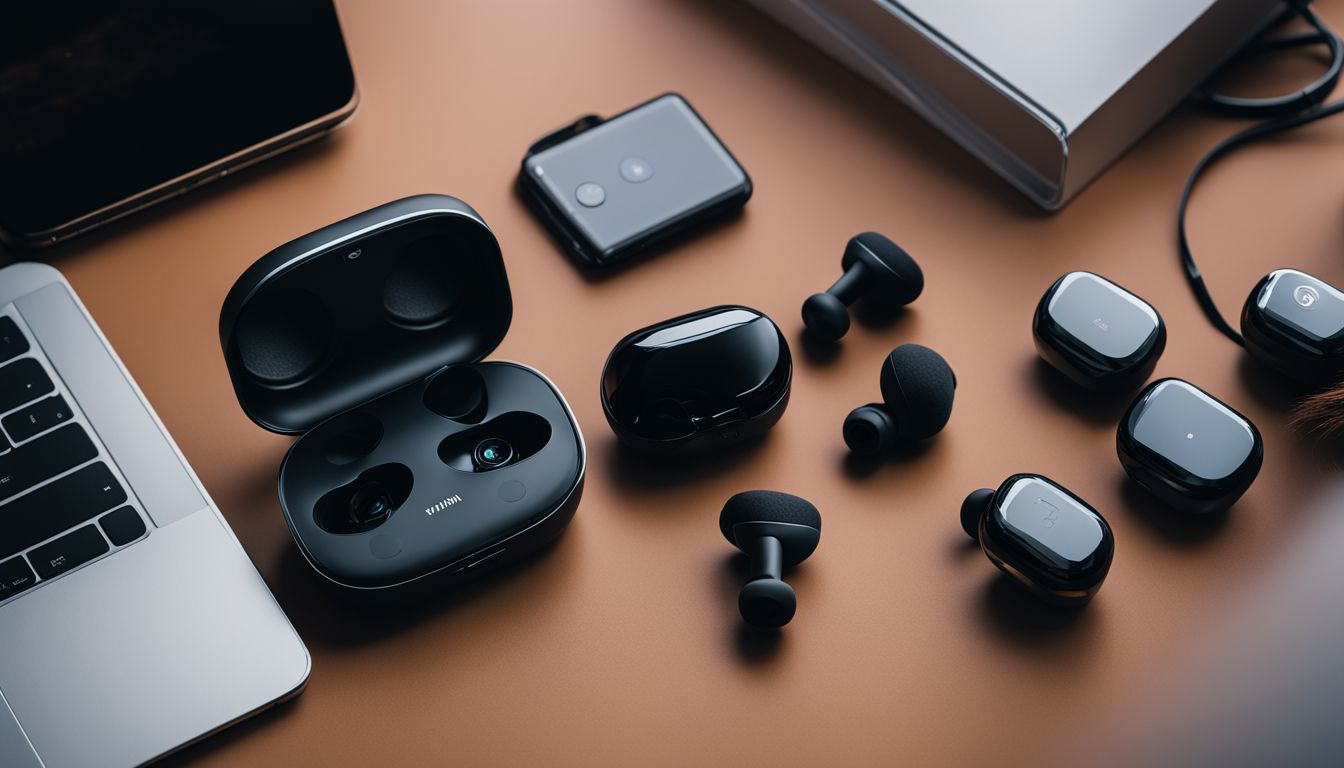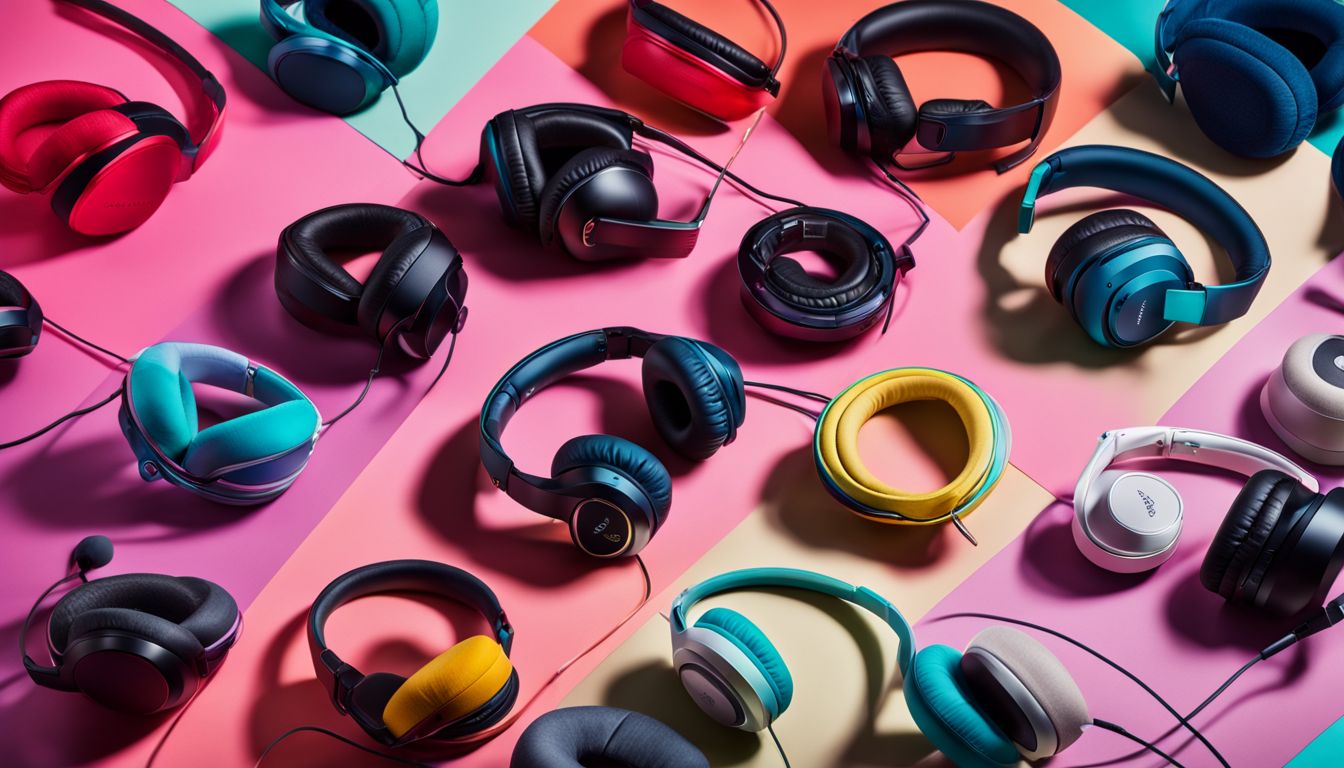- How to Choose Running Shoes for Different Terrains - January 2, 2024
- Improving Your Running Form: A Guide for Beginners - January 2, 2024
- The Science Behind Cushioning in Running Shoes - January 2, 2024
Last Updated on
Understanding the right pair of wireless earbuds to buy can be daunting with so many options in today’s market. For instance, did you know there are 15 different types of headphones, including some fantastic wireless earbuds? This comprehensive guide will help simplify your shopping experience by elaborating on each type’s unique features and benefits.
Keep reading to find out how the tiniest details could significantly enhance your audio experience!
Key Takeaways
- There are 15 different types of wireless earbuds, each with unique features and benefits.
- Some types of wireless earbuds include in-ear monitors, open-ear earbuds, bone-conduction headphones, headsets, and ambient sound headphones.
- Active noise-cancelling headphones utilize advanced technology to reduce external noise and provide an immersive listening experience.
- When choosing between wireless and wired headphones, consider factors such as sound quality, range, technology, and ease of use.
What are Wireless Earbuds and How Do They Work??

Wireless earbuds are small, portable devices that can be placed directly into the ears. They operate with the help of Bluetooth technology to connect with various gadgets such as smartphones and laptops.
Unlike traditional wired headphones, wireless earbuds don’t require a physical connection, offering freedom from tangled cords or the need for a headphone jack.
True wireless earphones represent one of the latest marvels in audio development. These sound-gearing tools fit comfortably inside your ears due to their ergonomic design. The operational dynamics stem from tiny batteries housed within them which power up these devices though it may affect longevity and overall performance over time.
Despite this, true wireless headphones rope in multiple benefits including convenience plus liberation from twisted wire hassles – all facets critical before any potential purchase decision is made.
Types of Headphones and Earbuds

Headphones and earbuds come in a myriad of forms, each designed to suit the diverse needs and preferences of listeners worldwide. Here are some types:
- Over-Ear Headphones: These models cover the entire ear, providing substantial isolation from outside noise.
- On-Ear Headphones: These sit on top of your ears instead of enveloping them completely.
- In-Ear Earbuds: They go inside your ears, usually with rubber or foam tips to make a snug fit.
- Open-Back Headphones: These allow air to pass through their ear cups to the speaker element.
- Closed-Back Headphones: They block out outside noise by sealing the speaker elements in the ear cups.
- Semi-Open Headphones: A hybrid of open-back and closed-back headphones providing a natural sound experience while reducing ambient noise.
- Noise-canceling headphones: Specialized headphones that reduce unwanted ambient sounds using active noise control techniques, perfect for those who wish for an enhanced listening experience.
- Bluetooth Wireless headphones: Offering wire-free convenience, these headphones connect to devices through Bluetooth, as mentioned in [IMPORTANT FACTS].
- Bone Conduction Headphones: Rather than emitting sound waves through your ear, these types transmit vibrations directly into your skull.
- Studio Monitor Headphones: Specifically designed for studio reference monitors with high-precision audio reproduction capabilities.
- Gaming Headsets: Equipped with additional features like built-in microphones for multiplayer online gaming sessions and interactive games.
- Sports Headphones: Primarily used for fitness activities, they’re typically waterproof and dust-resistant.
- DJ Headphone: Often over-ear or on-ear type earmuffs, they offer excellent bass response and outstanding sound pressure levels needed for DJing purposes.
- Clip-on Earbuds/ Earloop: Perfect for individuals involved in sports activities as they stay fixated on the ears.
- True Wireless Earbuds: They’re completely devoid of wires, individually inserted into each ear for unobstructed movement.
Different Types of Earbuds
Explore the various types of earbuds available in the market and find the perfect fit for your needs.
In-Ear Monitors
In-ear monitors (IEMs) are a game-changer for musicians, audio engineers, and audiophiles alike. They consist of three main components, the transmitter, receiver, and earphones. These compact devices house tiny drivers that transform electrical signals into sound, delivering an unparalleled listening experience.
In the world of IEMs, one can choose between wired or wireless models, with wireless gaining increasing popularity due to the freedom of movement they offer. Comfort is key when using these types of earbuds and it all comes down to finding the perfect-sized ear tips; custom options are available for those seeking a more personalized fit.
With such refined technology at use in producing high-quality sound output on go venues like concert stages or silent studios; in-ear monitors have become an essential tool for anyone serious about their auditory experiences.
Open-Ear Earbuds
Open-ear earbuds are a type of earbud that is recommended for those who experience ear fatigue from traditional in-ear headphones with silicone tips. These earbuds offer a comfortable fit without the need for isolating the ears.
Similar to bone-conduction technology, open-ear headphones allow users to enjoy their music while still being aware of their surroundings. With open-ear earbuds, you can have the convenience of wireless technology without completely blocking out external noise.
Bone Conduction Headphones
Bone conduction headphones are a unique type of earbuds that transmit sound through vibrations on the cheekbones, directly to the inner ear. Unlike traditional headphones that rely on air transmission through the ear canal, bone conduction headphones use specialized technology to bypass this process.
While they may not offer the same audio quality as other types of headphones, bone-conduction headsets have their benefits. They are particularly useful in work environments where it’s important to stay aware of surroundings while listening to audio.
These headphones can also be a good option for individuals with hearing impairments or those who prefer to keep their ears free for situational awareness.
Headsets
Headsets are a type of earbud that is commonly used for communication purposes. They typically consist of a pair of headphones with an attached microphone, allowing users to listen to audio and speak into the microphone at the same time.
There are various types of headsets available, including gaming headsets, which are specifically designed for gamers and provide immersive sound quality and clear voice communication.
Another popular type is Bluetooth headsets, which offer wireless connectivity to devices such as smartphones or computers, allowing users to enjoy hands-free calling or listening to music without the hassle of tangled wires.
Ambient Sound Headphones
Ambient sound headphones, also known as open-back headphones, are a type of earbuds that allow some environmental noise to pass through while you listen to music or other audio. These headphones are designed with small openings on the back of each earbud, allowing air and sound waves to freely move in and out.
The advantage of ambient sound headphones is that they provide a more natural listening experience by creating a spacious and open soundstage. However, because these headphones don’t offer as much noise isolation as other types, they may not be ideal for use in noisy environments or when you need complete focus on your audio.
Types of Headphones by Technology
Active Noise-Cancelling Headphones use advanced technology to block out external noise, providing a more immersive listening experience. To learn more about this and other types of headphones, read on!
Active Noise-Cancelling Headphones
Active noise-cancelling headphones are a type of headphones that utilize advanced technology to reduce external noise. These headphones are equipped with microphones that pick up ambient sounds and generate sound waves to counteract them, effectively canceling out the background noise.
This technology creates a peaceful audio environment by eliminating distractions and improving audio clarity. Whether you’re listening to music or making calls, active noise-canceling headphones provide an immersive audio experience by suppressing external noises and allowing you to focus on what matters most.
These headphones have revolutionized communication in noisy environments, making it easier to have conversations without being interrupted by background chatter or other disturbances.
Wireless vs. Wired Headphones
Wireless headphones use Bluetooth technology to connect to devices, providing flexibility and convenience, while wired headphones require a physical connection for audio playback.
Bluetooth vs. Traditional Connection
When it comes to wireless headphones, there are two primary types of connections under consideration: Bluetooth and traditional wired connections. Both offer unique benefits and drawbacks that can largely influence a buyer’s decision.
| Type of Connection | Sound Quality | Range | Technology | Ease of Use |
|---|---|---|---|---|
| Bluetooth | While Bluetooth has made significant strides in sound quality, it can sometimes be perceived as lacking when compared to a wired connection. However, the difference can be negligible to most users, especially with advancements in Bluetooth technology. | Bluetooth offers the convenience of mobility with a typical range of about 33 feet, though higher-end models can provide greater distances. | Bluetooth is a technology standard used for short-range wireless communication between electronic devices. It can be used to connect wireless headsets, transfer files, and enable hands-free calling. | Bluetooth headphones are generally easy to use, though some users may find pairing devices or managing multiple connections challenging. Despite this, the convenience of a wireless connection often outweighs these minor inconveniences. |
| Traditional Wired Connection | Wired headphones generally offer superior sound quality as they are not subject to signal interference or compression. This makes them a preferred choice for audiophiles. | Wired headphones are restricted by the length of their cable, which usually ranges from 3 to 12 feet. This lack of mobility can be limiting for some users. | Wired headphones use traditional analog signals to transmit sound, offering reliable and continuous audio playback without the need for charging or pairing. | Wired headphones are simple to use, requiring only an audio jack to connect to a device. However, they can be less convenient due to the presence of wires and potential tangling. |
Factors to Consider When Buying Earbuds
When buying earbuds, consider factors such as sound quality, comfort, and durability.
Sound Quality
The sound quality of wireless earbuds is a crucial factor to consider when making a purchase. It determines the overall audio experience you will have while using them. Good sound quality ensures that your music, podcasts, or phone calls are clear and enjoyable to listen to.
The bass response, treble performance, and sound accuracy all contribute to creating an immersive and satisfying listening experience. Additionally, noise isolation and soundstage also play a role in enhancing the overall sound performance of the earbuds.
So, when choosing wireless earbuds, make sure to prioritize sound quality for the best audio experience possible.
Comfort
Comfort is a vital consideration when purchasing wireless earbuds. You want to make sure that you can wear them for extended periods without discomfort. Look for earbuds with an ergonomic design that fits securely and comfortably in your ears.
Consider factors such as cushioning, pressure points, size, adjustability, and softness. Lightweight options are also desirable to prevent any strain or discomfort during use. Many renowned companies have put effort into improving the comfort of their wireless earbuds, so it’s possible to find affordable options that offer good levels of comfort while still delivering excellent sound quality.
prioritize your comfort when selecting the perfect pair of wireless earbuds for your needs.
Durability
Durability is a crucial factor to consider when purchasing wireless earbuds. You want a pair that can withstand daily use and potential accidents. Look for earbuds with an official IP rating for durability, indicating their water resistance and ability to handle dust and sweat.
It’s also important to choose a reliable brand known for producing high-quality products that last longer. Keep in mind that wireless earbuds have small batteries with limited lifespans, so you may need to sacrifice longevity for the convenience of a wire-free experience.
Conclusion
In conclusion, understanding the different types of wireless earbuds is crucial for anyone looking to purchase a new pair. With options ranging from in-ear monitors to bone-conduction headphones, there is something for everyone’s preferences and needs.
By considering factors such as sound quality and comfort, individuals can make an informed decision on which type of earbuds will enhance their music experience on the go.
FAQs
1. What are the different types of wireless earbuds?
The different types of wireless earbuds include in-ear, on-ear, and over-ear styles.
2. How do in-ear wireless earbuds work?
In-ear wireless earbuds fit snugly inside the ear canal and use Bluetooth technology to connect wirelessly to devices.
3. What are the advantages of on-ear wireless earbuds?
On-ear wireless earbuds rest on the outer ears and provide a comfortable fit while allowing ambient sounds to be heard.
4. Are over-ear wireless earbuds suitable for sports activities?
Over-ear wireless earbuds are generally not suitable for intense physical activities as they may be bulky or less secure during movement.
5. Can I use my wireless earbuds with multiple devices?
Yes, most wireless earbuds can be paired with multiple devices such as smartphones, tablets, or laptops for versatile use.

